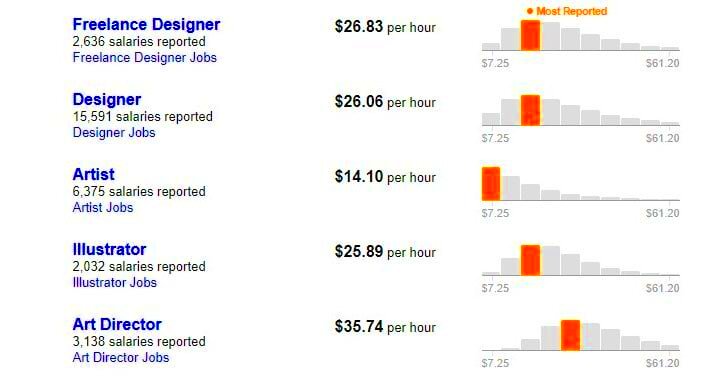Freelance artists often face difficulty in deciding their charges for various reasons. It’s essential to ensure that you are paying yourself right when attracting clients with either start-up level of career or extensive work related experience in this area otherwise you won’t stay afloat financially even if this is something easy to do nowadays. One thing that stands out about freelance jobs compared to permanent ones is their flexibility, but this comes at a cost- you need to think hard about your pricing strategy. The first step towards having a commendable freelance career is understanding how to price your illustrations fairly.
Factors That Influence Illustrator Rates

Various elements can influence the cost of hiring freelance illustrators. Here are some pointers to assist you in creating an appropriate pricing model:
- Experience: More experienced illustrators can charge higher rates due to their skill level and portfolio.
- Project Complexity: Complex illustrations requiring more time or intricate detail will naturally cost more.
- Time Required: Time is a key factor. Illustrators often base their fees on how long it will take them to complete a project.
- Client Budget: Some clients have larger budgets, while others may have a strict limit. Knowing your client’s budget helps tailor your pricing.
- Market Rates: It’s important to consider what other illustrators with similar experience and skill levels are charging.
- Rights and Licensing: Will the client have exclusive rights to your work, or is it a one-time usage? Licensing affects the price.
Taking into account all those things will enable you to come up with a rate that is not only reflective of what your efforts are really worth but is also competitive enough.
Also Read This: How to Promote Your Fiverr Gig: Bangla Tutorial
Comparing Hourly vs. Project-Based Fees
It is often discussed among freelance illustrators whether they should charge on an hourly basis or for each specific project. Every method has its advantages and disadvantages, determined by different types of jobs as well as individual inclinations.
| Hourly Fees | Project-Based Fees |
|---|---|
|
|
In case it’s a simple project and you could give an exact estimation of time required for its completion, project fees might suit better. For extensive or evolving work, hourly charges seem to be the right thing to go with. Although, the decision must be based on individual requirements of each client and illustrator.
Also Read This: How to Earn from Fiverr in Hindi
How Experience and Skill Level Affect Rates
Freelance illustrator rates depend heavily on individual experience and job difficulty level. The qualities of artwork required for traders is such that they measure value against quality and efficiency, hence, this also affects the amount they may be willing to spend. You will have built up your style and improved your skills over time, which is why you can get away with demanding higher fees as your portfolio will show.
What most often dictates how much you will be charged is your expertise and how long you have been doing this kind of work.
- Entry-Level: If you're just starting out, it’s common to charge lower rates. This helps build your portfolio and attract clients. Expect to earn between $20 to $50 per hour.
- Mid-Level: With a few years of experience and a solid portfolio, you can raise your rates to around $50 to $100 per hour, depending on the complexity of the work.
- Senior-Level: Highly experienced illustrators with an established reputation can command rates of $100 or more per hour. Clients often seek these professionals for their expertise and unique style.
To be honest, the greater the level of experience that an individual possesses, the more reasonable they can set their prices. Consequently, it is essential for one to be flexible and modify their rates whenever necessary as they improve in skills and create a good collection of works.
Also Read This: Understanding Impressions on Fiverr: What It Means for Your Success
Setting Fair Prices for Different Types of Illustrations
There are various rates that can be attributed to various forms of illustrations when it comes to pricing them. Knowing how different types work will help you make sure that you are charging what is right. Below is a brief summary:
| Type of Illustration | Typical Price Range |
|---|---|
| Children's Book Illustrations | $50 - $150 per illustration |
| Editorial Illustrations | $100 - $300 per illustration |
| Marketing and Advertising | $150 - $500 per illustration |
| Custom Commissions | $200 - $1,000+ depending on complexity |
The intricacy of design, its intended application as well as the target audience are some of the things to consider when setting your prices. It is generally more expensive to treat illustrations for commercial use than it is for personal projects because of their wider audience and higher potential income individual works. It’s also crucial that you ensure your pricing remain competitive while compensating yourself adequately for the time and effort you’ve put into creating these pieces.
Also Read This: How to Sell on Fiverr Mobile: A Complete Guide
Tips for Negotiating Rates with Clients
The task of negotiating rates with potential clients can be quite daunting for many freelance illustrators out there. However, it is an essential skill that needs to be honed. Here are a few suggestions on how to navigate negotiation conversations so that you are not left in a fix:
- Know Your Worth: Research industry standards and have a clear understanding of your skills and experience. This knowledge will give you confidence during negotiations.
- Be Open to Discussion: Listen to your client’s budget constraints and be prepared to find a middle ground. Flexibility can lead to better long-term relationships.
- Highlight Your Value: Share your portfolio and any relevant experience that demonstrates your unique style and expertise. Clients are often willing to pay more for quality work.
- Set Clear Boundaries: Be upfront about what your rates include. If additional revisions or services are requested, clarify any extra costs to avoid misunderstandings later.
- Practice Confidence: When presenting your rates, do so with confidence. If you believe in your pricing, clients are more likely to see the value.
Never forget that negotiations can be conducted without confrontations. By utilizing appropriate strategies, you can have an agreeable price with your clients paving way for great future partnerships.
Also Read This: How Long Does Fiverr Take to Pay Out?
Common Mistakes to Avoid When Pricing Your Work
Determining how much to charge as a freelance illustrator may be challenging, and several of them make blunders which can affect their income or relationship with clients. Knowing these frequent errors will help you stay away from them when pricing your services!
Be cautious of these blunders:
- Underpricing Your Services: It’s tempting to set low rates to attract clients, but this can undermine your value and lead to burnout. Remember, quality work deserves fair compensation.
- Not Considering All Expenses: When calculating your rates, make sure to factor in costs like software, equipment, and taxes. These expenses can add up and should be reflected in your pricing.
- Ignoring Market Trends: Prices fluctuate based on demand and trends. Stay informed about what other illustrators in your niche are charging to ensure your rates remain competitive.
- Failing to Communicate Clearly: Always communicate your rates and what they include upfront. Misunderstandings can lead to frustration for both you and your clients.
- Not Adjusting Your Rates Over Time: As you gain experience and improve your skills, don’t hesitate to raise your rates. Regularly reassess your pricing structure to reflect your growth.
If you avoid these mistakes normally made, it would be possible to have a more sustainable freelance career while developing better relationships with your clients.
Also Read This: How to Post a Fiverr Gig
FAQs About Freelance Illustrator Pricing
There are a lot of questions that come to minds when it comes about determining freelance illustrator prices, some common concerns can be clarified by visiting some of these frequently asked questions:
- What should I charge as a beginner? As a beginner, you might consider charging between $20 to $50 per hour. Focus on building your portfolio and experience.
- How do I determine my project pricing? Consider the complexity of the project, the time required, and the client’s budget. Research similar projects to gauge appropriate pricing.
- Should I charge more for revisions? Yes, if a client requests multiple revisions beyond what was agreed upon, it’s fair to charge additional fees.
- How do I handle clients with a low budget? Be open to discussion. You can offer different options or suggest a scaled-down version of the project that fits their budget.
- When should I raise my rates? Consider raising your rates when you gain more experience, improve your skills, or after completing successful projects that showcase your value.
Confidence can be built by knowing exactly how to answer these questions.
Conclusion: Finding the Right Balance in Pricing
To make it as a freelance illustrator, it is very important to strike the appropriate price balance for one’s work. In order to strike this balance, you need to know your worth, be knowledgeable about market trends and take into account the costs you incur. Always remember that the pricing must be indicative of the quality and uniqueness of your work.
A few final thoughts that can assist you in achieving that balance are:
- Be Honest with Yourself: Know your skills and experience level, and price accordingly. Don’t undervalue your work.
- Stay Flexible: Be open to negotiating with clients while maintaining your minimum rate. Flexibility can lead to repeat business.
- Regularly Reassess Your Rates: As you grow in your career, regularly review and adjust your rates based on your experience, market trends, and client feedback.
- Build Client Relationships: Strong relationships with clients can lead to referrals and repeat work. Focus on delivering value and maintaining clear communication.
Adjusting and implementing these tips will make you develop applicable pricing strategies that aid in your journey as a creator without neglecting the need to pay yourself appropriately.




